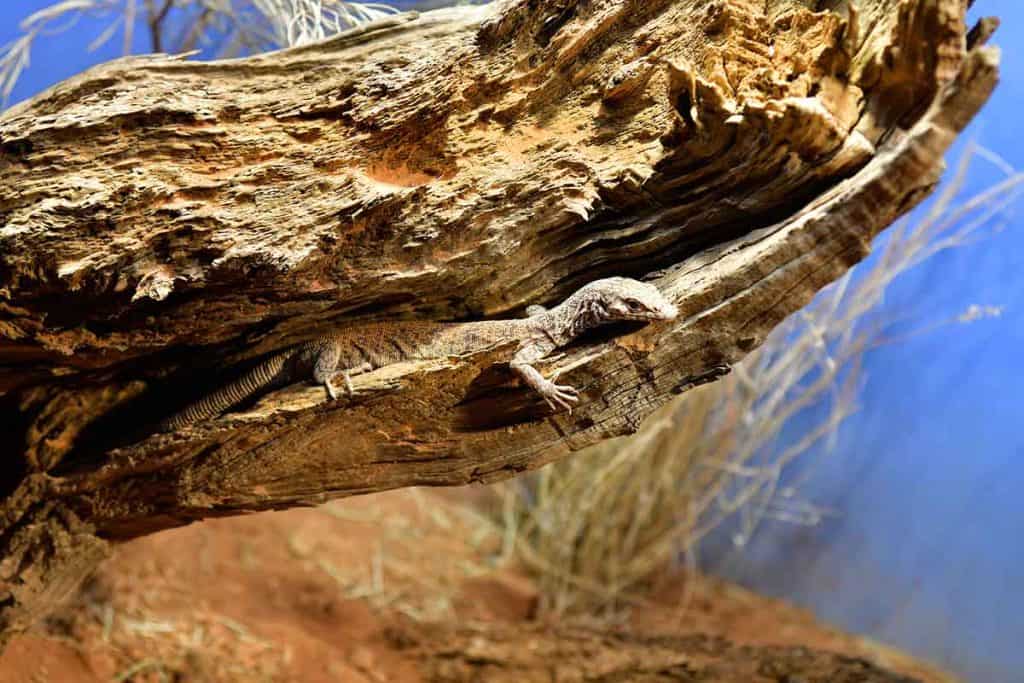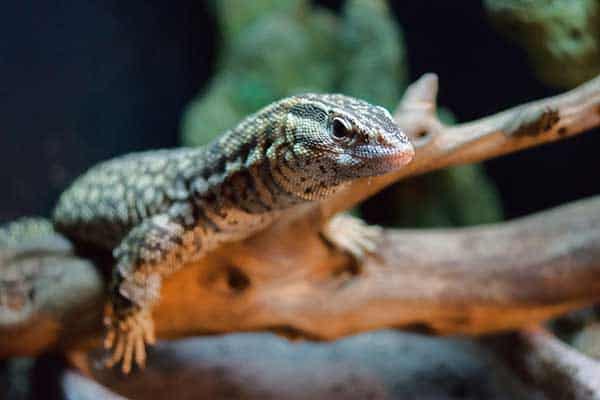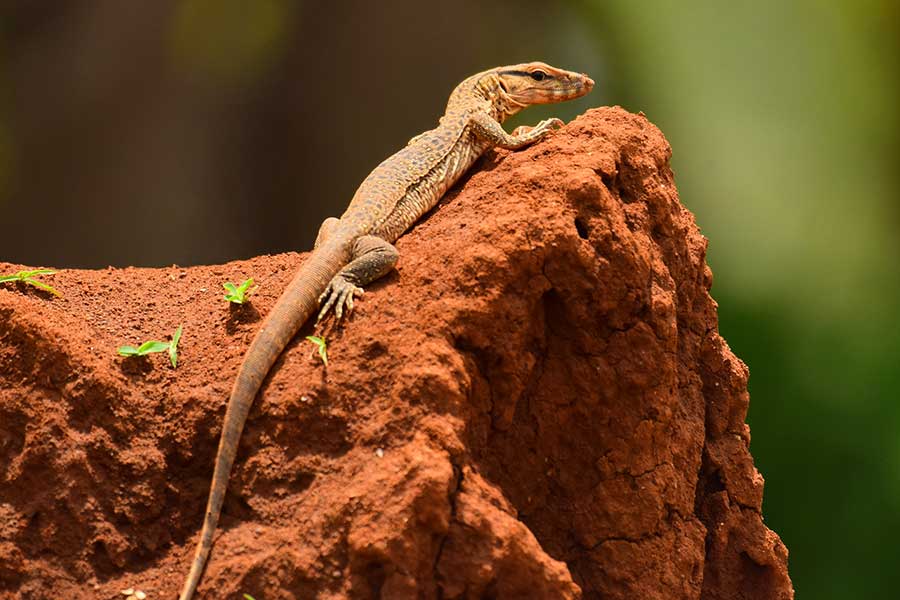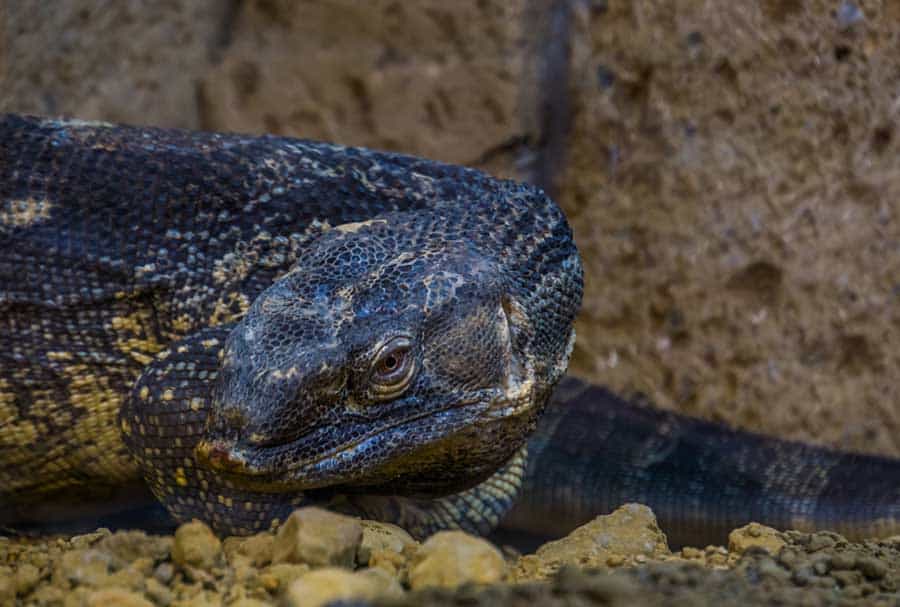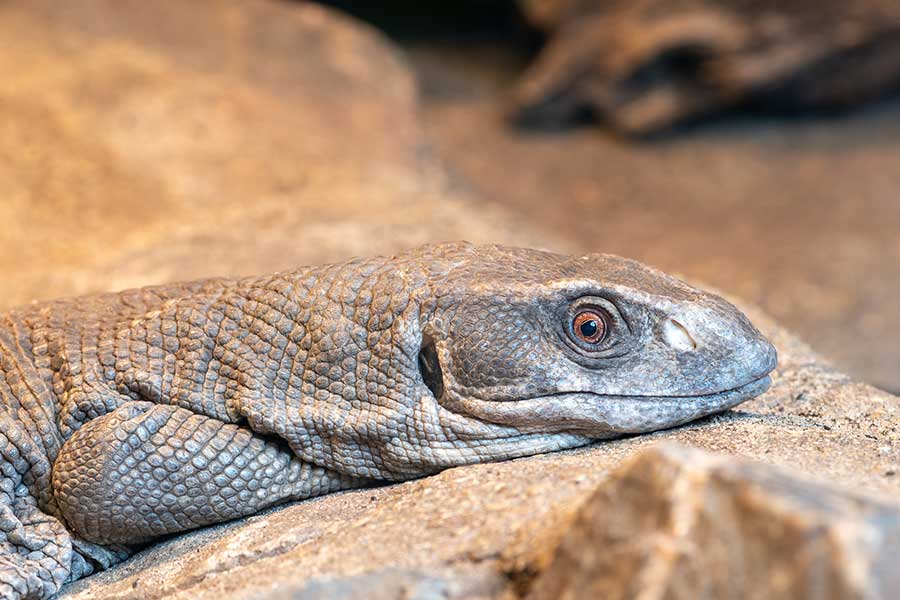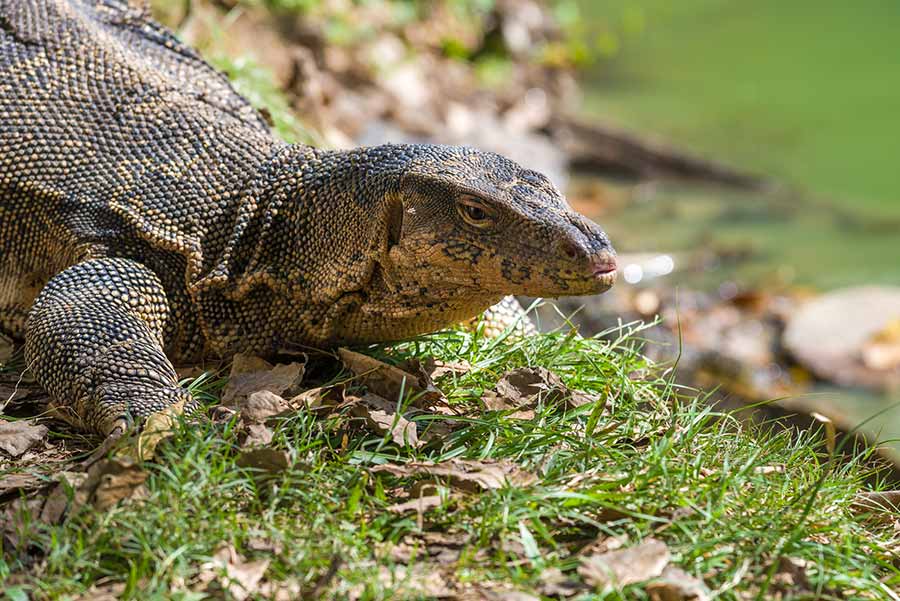Monitor lizards have become increasingly popular in the reptile community, and if you are here, that means you are interested in getting one of your own! There are over 80 species of these massive, majestic lizards, so which is the best pet monitor lizard for you?
Monitor lizards are by far some of the most intelligent reptiles you can own as a pet. However, they are definitely not beginner reptiles, mostly due to their size and strength, and they certainly do not suit everyone’s abilities or lifestyle.
However, you can have a good bond with your monitor if you tame it down properly by spending lots of time socializing them as early as possible. Monitors can come to recognize their owners, learn tricks, go for walks, and even cuddle up against you for warmth.
At the same time, though, their jaws are powerful enough to snap off fingers, their claws are long and sharp enough that you may need a hospital visit and stitches, and their tails are strong enough that they can leave you with deep tissue bruises.
It takes a very specific owner to care for a monitor lizard. Read on to see if caring for a monitor lizard is in your realm of capabilities.
Which Is the Best Pet Monitor Lizard?
This table is an overview of the five monitor lizards on this list. They are in order of which monitor is easier to take care of and which is the most complicated.
There are over 80 recognized species of monitor lizards, and many of them have made their way into the pet trade. Some are more available than others as they are easier to breed in captivity. The above species are some of the most common monitor lizards kept as pets.
The term ‘puppy dog tame’ gets thrown around when talking about taming down monitors. This term is misleading because these monitors will never be as tame as a domesticated dog. They can and will do serious harm to you if you aren’t careful and responsible!
Read on as we break down these species’ characteristics and care requirements in more depth below.
1. Ackie Monitor
While monitors are definitely not for newbie herpers, the Ackie monitor is the best monitor if you don’t have much prior experience with these kinds of lizards.
Quick Facts
- Average Length: 16 to 18 inches
- Average Weight: 5 to 12 pounds
- Average Lifespan: 15 to 20 years
- Average Cost: $100 to $200
- Minimum Enclosure Size: 4 x 4 x 2 feet
- Habitat Needs: Arid terrestrial burrower and rock dweller
The Ackie monitor is one of the smallest monitor species. However, it is not the smallest on this list. Its size makes it one of the more popular monitor species to own as a pet because it is easier to handle and cheaper to feed and house.
Enclosure
While they are one of the smaller monitor species, Ackies need a large enclosure by other lizards’ standards. A 60-gallon bearded dragon enclosure might seem large until you realize how much space even the smaller monitors need to move around.
Ackie monitors come from Australia and inhabit the dry desert regions. This means their enclosures in captivity need to mimic these conditions as closely as possible.
The Ackie monitor needs a very hot enclosure, with a basking spot of 150°F to be precise! This is incredibly hot and will require special UVB lighting for 12 hours a day, which will be a considerable contributor to your electricity bill.
Diet
Their diet should consist of high protein insects such as Dubia roaches, Phoenix worms (also known as NutriGrubs and black soldier fly larvae), hornworms, crickets, grasshoppers, and mantids. Once a month, you can feed your Ackie monitor a couple of mice pinkies.
Habitat Needs
Ackie monitors need perches, rocks, caves, and perches to climb in their enclosures. These need to be sturdy and large enough to hold the monitor’s weight.
While they need the height and objects to climb on and around, they also need a substrate that is deep enough to burrow in. There should be plenty of rocky outcroppings in their enclosure for them to feel at home.
Temperament
Ackie monitors are agreeable in temperament and not prone to snapping at their handlers if they are tamed down and socialized properly. They are very intelligent and can be taught to do tricks!
The Ackie monitor can be housed with other Ackies. However, you should not house more than one male together, and for each Ackie monitor you add, you will need to add at least 2 feet to the enclosure.
2. Pygmy Mulga Monitor
Pygmy Mulga monitors also make good first-time monitors for reptile owners because of their smaller size and calm temperament. However, their high cost is usually a deterrent.
Quick Facts
- Average Length: 12 to 16 inches
- Average Weight: 60 to 80 grams
- Average Lifespan: 8 to 18 years
- Average Cost: $600+
- Minimum Enclosure Size: 3 x 1.5 x 3 feet
- Habitat Needs: Arid arboreal
The Pygmy Mulga is the smallest monitor on this list. It is a favorite of monitor hobbyists because it is simple to take care of compared to other monitors. Most of this is due to size, since when the monitor is down-sized, so is the enclosure, the amount of heat and light, the electricity bill, and the food bill.
Because they are so great to keep as pets and because they are hard to find in captivity, any breeder you contact may have a waiting list that is a couple of years long. Be sure to do your research and make sure you want this kind of commitment, as Pygmy Mulgas and most other monitor lizards can live for 10 to 20 years.
Enclosure
Pygmy Mulga monitors are also native to Australia’s sandy deserts. This means they need a drier enclosure with high heat and moderate humidity.
They can be housed together with others of their species as long as you add 2 feet for every monitor in the enclosure. Housing multiple males together is not a good idea, as they will wrestle during breeding season.
Their basking spot needs to be at 150°F for 12 hours a day. This means they need quality UVB and heat lighting for a long period, which does end up being expensive.
Diet
Pygmy Mulgas are very similar to Ackie monitors in that they feed on insects. They should be fed daily with as many insects as they will eat in a 15-minute period.
Staple insects include Dubia roaches, Phoenix worms (also known as NutriGrubs and black soldier fly larvae), hornworms, crickets, grasshoppers, and mantids. They can treat insects such as butterworms and waxworms once or twice a week.
Habitat Needs
Pygmy Mulga monitors need a very dry substrate that they can burrow into, hides, hollow logs, and caves to run over and hide in, as well as vertical climbing space with secure branches and perches.
Temperament
Pygmy Mulgas have excellent temperaments and are not known for being snappy. They love a good cuddle and can end up being a lizard that you sit at your desk and work with on your shoulder for a couple of hours!
3. Black-Throated Monitor
Black throated monitors are incredibly large and weigh a considerable amount, which can make them challenging to house and handle. However, they are favorites in the reptile community because they are even tempered and can bond with their owners very well.
Quick Facts
- Average Length: 4 to 7 feet
- Average Weight: 40 to 60 pounds
- Average Lifespan: 20 to 25 years
- Average Cost: $600+
- Minimum Enclosure Size: 14 x 6 x 4 feet
- Habitat Needs: Arid terrestrial
These monitors come from Tanzania, a country in eastern Africa that is very dry and sandy. Black-throated monitors can be gentle giants if you know how to take care of them. However, they are still mostly wild animals and can turn on their owners at a moment’s notice.
Due to their size, if and when they do snap at their owners, they can take a couple fingers off in the process or claw you badly enough that you need several stitches. Early and consistent handling and socialization from a young age is essential if you want an even-tempered, docile pet lizard.
Enclosure
The enclosure of a black-throated monitor needs to be at least twice its length. You will not find these enclosures for sale in your pet store because they need to be custom built. Many people simply devote an entire room in the house to their black-throated monitor.
Diet
Black-throated monitors need to be fed a variety of rodents, eggs, and large insects. They are carnivores and need plenty of protein to support their massive bodies. Avoid feeding your large monitor chicks and other birds and rather go for rodents because birds have less
Habitat Needs
In terms of special habitat needs, the black-throated monitor is fairly simple to take care of aside from its large size. They need a large water container to soak in. They also need a fair amount of heat and good, strong UVB light for 12 hours a day.
Temperament
It is essential that these monitors be properly tamed down and socialized as babies before they become behavioral problems that weigh 60 pounds and can cause fatal damage if they choose to attack you.
However, if they are tamed down properly early on, then they can be a pleasure to own. Not everyone feels the same way about them, though, and finding a decent pet sitter or housekeeper may be difficult because of their size and intimidating appearance.
4. Savannah Monitor
Savannah monitors are the most common monitor in the pet trade. Unfortunately, they tend to live shorter lives in captivity of about 5 years due to improper husbandry and obesity. If you choose to take on a Savannah monitor, make sure you have the space and financial capability to do so properly.
Quick Facts
- Average Length: 3.5 to 5 feet
- Average Weight: 11 to 13 pounds
- Average Lifespan: 15 to 20 years
- Average Cost: $25 to $100
- Minimum Enclosure Size: 8 x 4 x 4 feet
- Habitat Needs: Arid terrestrial burrower
Savannah monitors come from all over Africa. They come from the savannas, as their name suggests, which are dry, sandy, grassy open spaces. This means their enclosure setup is fairly simple to establish.
Enclosure
The Savannah monitor needs an incredibly large enclosure and should be at least double the length of your lizard.
They need this space to remain active and avoid obesity. If they cannot have this space in their enclosure then they need to be able to roam around the whole house freely and be taken for walks every day.
Diet
Savannah monitors are carnivores and will occasionally eat a particularly large, juicy insect.
The insects mentioned for the Ackie and Pygmy Mulga monitors can be fed to the Savannah monitor too. However, they should not be fed waxworms and butterworms, as they put on unhealthy weight very easily. A protein-rich yet lean diet is essential for a healthy Savannah monitor.
Their diet also consists of rodents, crayfish, molluscs, and eggs.
Habitat Needs
Savannah monitors are burrowers and need a loose substrate deep enough that they can burrow into to cool down or feel safe. They should also have plenty of hollow logs and caves embedded into the substrate to help them feel secure in their burrows.
Temperament
Savannah monitors are known to be calm and even-tempered. However, due to their size, they can turn nasty if they feel cornered, are not socialized properly, or are hurt.
If you let your monitor roam around your house to get exercise, make sure you are always looking where you walk or sit, because if you accidentally hurt your Savannah monitor they will turn around and snap at you, even if they are normally docile.
5. Dumeril’s Monitor
Dumeril’s monitor is the largest on this list. They have a shorter life span than most monitor lizards, which makes it seem as though they are less of a financial commitment. However, they are semi-aquatic, which means your financial and time investment will be substantial even though they live half the time of a Savannah monitor.
Quick Facts
- Average Length: 3 to 5 feet
- Average Weight: 110 pounds
- Average Lifespan: 8 to 10 years
- Average Cost: $250 to $300
- Minimum Enclosure Size: 10 x 4 x 4 feet
- Habitat Needs: Tropical semi-aquatic
The Dumeril’s monitor is an exquisite lizard and is a favorite amongst reptile owners who are very experienced and love their semi-aquatic species.
Enclosure
The Dumeril’s monitor comes from Southeast Asia, which means that its natural habitat is very hot and very humid. It needs a constant humidity of 80% and a temperature range of 80????F to 120????F.
This also means you will need to install a misting system if you cannot commit to manually misting the enclosure three times a day. Because their enclosures are so large, it will take a large amount of effort and electricity to maintain the heat and humidity. Be prepared to invest a lot of time and money into ensuring your Dumeril’s monitor’s enclosure is set up and running properly.
Diet
Like most monitor lizards, Dumeril’s monitors are strict carnivores and subsist on a diet of rodents. However, you can also give them a crab or crayfish as a treat when you are able, as they eat plenty of aquatic crustaceans in the wild.
Habitat Needs
Dumeril’s monitors are semi-aquatic and need an enclosure that has a large pool in it. They eat and defecate in the water, so it needs to be filtered or cleaned out daily to avoid them getting sick.
Temperament
Dumeril’s monitors are quite shy and will need a lot of coverage in their enclosures to feel secure. However, they will become used to their owners with consistent and patient socialization.
Keep in mind that this does not mean that you do not need to be vigilant. Even ‘tame’ Dumeril’s can be aggressive and snap at you, and they can do quite a bit of damage due to their size and strength.
FAQ: Does My Monitor Need a Calcium Supplement?
Monitors are at huge risk of developing metabolic bone disease. This is for a variety of reasons that changes with the species of monitors; for example, some do not get enough sun, some do not eat the right food, and others do not absorb
Metabolic bone disease happens when there is not enough
This means you must dust their food with a
Chomping Off…
Monitors live for a very long time, averaging at 20 years. They are big, difficult to take care of, and cost a lot of money. They are not suitable for beginner reptile owners, but they are a pleasure to own if you have some reptile experience under your belt and are looking for a long-term (yet costly!) commitment.
After serious consideration, the five monitors listed in this article are the best pet monitor lizards for a number of reasons: their size, their availability, their care needs, and their temperaments all make for healthy relationships between monitor and owner.

